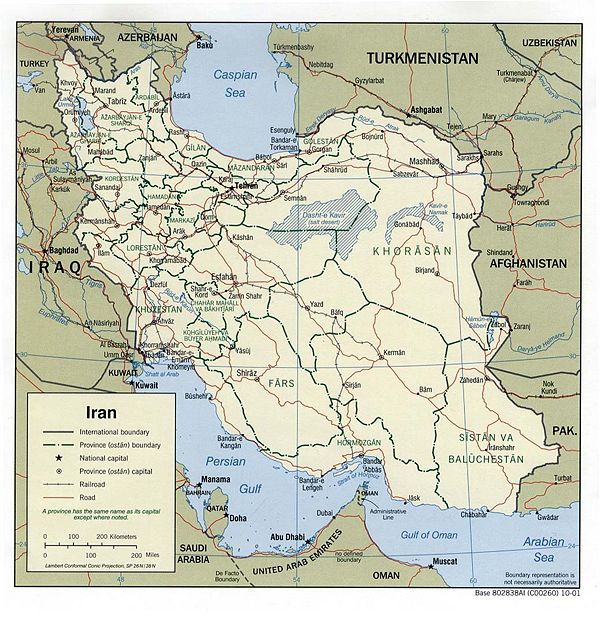Iran
Iran (Persian language: ايران, meaning "land of the Aryans"), officially the Islamic Republic of Iran (Persian language: جمهوری اسلامی ايران), is a Middle Eastern Islamic Republic. It is seen as the descendant of the Ancient Persian Empire and Persians make up an ethnic majority of the Iranian population. The official language of the country is Persian. The official religion of the country is Twelver Shi'a Islam.
Geography
Iran borders the Caspian Sea and Turkmenistan to the north, Iraq and the Persian Gulf to the west and south, and Afghanistan and Pakistan to the east. Iran, largely mountainous and prone to earthquakes, is mostly situated on the Iranian Plateau. The centre of the country is dominated by two large deserts with very little life and the majority of people live in the western half of the country.
History
Iran is one of the world's most ancient civilizations. Iranians, called Persians by the Greeks, built a huge empire in the 6th and 5th centuries BC before being conquered by the Greeks under Alexander the Great and then by the Romans. Iran regained part of its empire under the Sassanids before they were conquered by the Arabs, who introduced Islam and greatly influenced the Iranian culture and language. Iran was ruled by the Arabs for several hundred years, then by a succession of tribal dynasties after the Arab empire under the Caliphs broke up. The Safavids gained control of Iran in the 16th century and brought a new golden age to Iran. The Safavid empire collapsed in 1722, and Iran increasingly came under the influence of various European powers. In the early 20th century, the Pahlavi dynasty consolidated power. It ruled until 1979, when the Iranian revolution established the current Islamic Republic. Invaded by Iraq in an attempted land-grab in 1980, the Iran-Iraq War concluded in 1988. Despite initial disorganization and casualties in the hundreds of thousands, the new regime consolidated its power in its territorial defense.
Politics and Government
Since Khomeini's revolution, the Iranian Government has always been a complex theocratic republic. In the 2000s, it had an elected Parliament (Majlis); a President as the head of the executive branch of the Iranian Government; and a Supreme Leader as head of state and commander of the armed forces.
The Supreme Leader was chosen by the Assembly of Experts, made of 86 jurists; a Council of Guardians comprising of six clerics and six jurists who interpreted the constitution and also apply sharia law to Iran; and the Expediency Council who served as an advisory council to the Supreme Leader and were in charge of mediating disputes between the Parliament and the Council of Guardians.
Demographics
The majority of Iranians are ethnically Persian. Other ethnic groups, such as Azeris, make up significant minorities of the population.
Culture
- See also: Iranian cuisine
Iranian culture is a rich combination of Persian and Arabic influences. Islam plays an important role.
Languages
The main language of Iran is Persian, also called Farsi. Many other languages are spoken by members of different ethnic groups.
